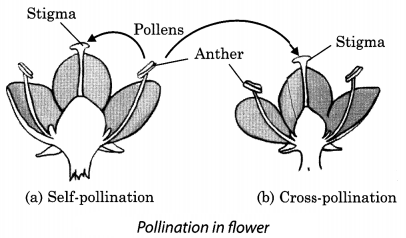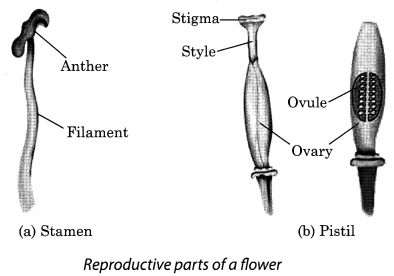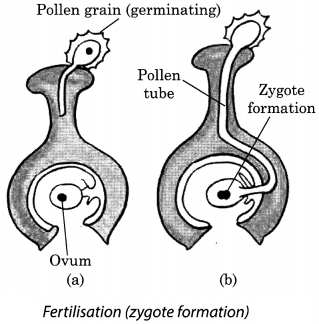In this page, we are providing Reproduction in Plants Class 7 Extra Questions and Answers Science Chapter 12 pdf download. NCERT Extra Questions for Class 7 Science Chapter 12 Reproduction in Plants with Answers will help to score more marks in your CBSE Board Exams.
Class 7 Science Chapter 12 Extra Questions and Answers Reproduction in Plants
Extra Questions for Class 7 Science Chapter 12 Reproduction in Plants with Answers Solutions
Reproduction in Plants Class 7 Extra Questions Very Short Answer Type
Question 1.
Fungus, moss and fern reproduces by a common method of asexual reproduction. Name the method.
Answer:
Spore formation.
Question 2.
Boojho had the following parts of a rose plant-a leaf, roots, a branch, a flower, a bud and pollen grains. Which of them can be used to grow a new rose plant?
Answer:
A branch.
Question 3.
What is zygote?
Answer:
Zygote is a diploid cell formed from the fusion of male and male and female gametes.
Question 4.
By which method of asexual reproduction sweet potato reproduces?
Answer:
Vegetative propagation.
Question 5.
In the vegetative propagation, the new plants are exact copies of the parent cell. Why?
Answer:
Because they are produced from a single parent.
Question 6.
What are produced by plants as a result of sexual reproduction?
Answer:
Seeds.
Question 7.
Which type of reproduction produces a new plant which is exact copy of the parent plant?
Answer:
Vegetative propagation.
Question 8.
What is a bud?
Answer:
A small bulb-like projection coming out from the yeast cell is called a bud.
Question 9.
Which part of the seed germinate into a small seedling?
Answer:
Embryo.
Question 10.
How does a moss plant reproduce?
Answer:
By means of spores.
Question 11.
Which type of bodies are spores?
Answer:
Asexual reproductive bodies.
Question 12.
What type of flowers does Petunia have?
Answer:
Bisexual flowers.
Question 13.
Where is the egg-formed?
Answer:
In an ovule.
Question 14.
What is sexual reproduction?
Answer:
Reproduction in which both male and female gametes are involved is called sexual reproduction.
Question 15.
What produces male gamete?
Answer:
Pollen grain produces male gamete.
Question 16.
What protects pollen grains from drying up?
Answer:
A tough protective coat prevents them from drying up.
Question 17.
What are bisexual flowers?
Answer:
The flowers that contain both stamens and pistil are bisexual flowers.
Question 18.
What are unisexual flowers?
Answer:
The flowers which contain either only the pistil or only the stamens are called unisexual flowers.
Question 19.
Pollen grain can be carried away by wind or water. Why?
Answer:
They are light.
Question 20.
Name two fruits which are fleshy and juicy.
Answer:
Mango and apple.
Question 21.
Name two hard fruits.
Answer:
Almonds and walnuts
Question 22.
Name the agents of seed dispersal.
Answer:
Wind, water, animals and human beings.
Question 23.
How are seeds dispersed in the case of castor and balsam?
Answer:
When the fruits of castor and balsam burst with sudden jerks, the seeds are dispersed.
Question 24.
Name two plants in which seeds are dispersed by animals.
Answer:
Xanthium and Urena.
Reproduction in Plants Class 7 Extra Questions Short Answer Type
Question 1.
How many types of reproduction are there in plants? Explain.
Answer:
There are two types of reproduction in plants:
- Sexual reproduction
- Asexual reproduction
(i) Sexual reproduction; The mode of reproduction in which new plants are produced from seeds by involvement of both male and female gametes.
(ii) Asexual reproductions In this mode of reproduction, new plants are produced without seeds by involvement of single parent.
Question 2.
Explain vegetative propagation.
Answer:
It is a type of asexual reproduction i n which new plants are obtained from vegetative parts like roots, stems, leaves or buds of the parent plants. For example, sweet potato and Dahlia give rise to new plants by roots, roses by stems, etc.
Question 3.
How do cacti plants reproduce?
Answer:
Cacti plants produce new plants from any part which get detached from the main plant body. Each detached part grow into a new plant. This is a type of asexual reproduction.
Question 4.
Some plants reproduce by cutting. Explain.
or
How does new plant produce by cutting?
or
How does rose plants reproduce?
Answer:
Cutting is a process through which many plants are propagated through asexual reproduction. For example, rose plant is propagated through this process. A part of stem from the desired plant is cut. The cutting of the plant is buried in the soil. The cutting is watered every day. After some time the leaves and roots arise from the nodes of the cutting. With time the cutting develops into a new plant.
Question 5.
What is budding? Explain with an example.
Answer:
The process of formation of an additional outgrowth, as bud, which gets detached from the parent cell to produce new individual is called budding. For example, the yeast grows asexually by process of budding. The small bulb like projection coming out from the yeast cell is called bud. It gradually grows and gets detached from the parent cell and forms a new yeast cell. Sometimes, another bud arises from the bud forming a chain of buds.
Question 6.
What is fragmentation? Give an example.
Answer:
Fragmentation is one of the types of asexual reproduction. In this type, plants like Spirogyra, breaks up into two or more fragments or pieces. Each fragment develops into a new individual. When water and nutrients are available algae grow and multiply rapidly by fragmentation.
Question 7.
Explain reproduction through spore formation.
Answer:
Reproduction through spore formation is a type of asexual reproduction. Spores are small spherical bodies covered with a protective coat. The coat protects the spore from unfavourable conditions. The coat burst and spore germinate into new plants when the conditions are favourable. The fungi on a bread piece grow from spore which are present in the air. Plants such as moss and fern also reproduce by means of spores.
Question 8.
Define two types of flowers with examples.
Answer:
Flowers are the reproductive parts of a plant. There are two types of flowers-
- unisexual and
- bisexual flowers.
The flowers which contain either only the pistil or only the stamens are called unisexual flowers, e.g., corn and papaya. On the other hand, the flowers which contain both stamens and pistil are called bisexual flowers, e.g., mustard and rose.
Question 9.
What is pollination?
Answer:
The transfer of pollen grains from the anther to the stigma of a flower is called pollination. Pollen grains are light so they can be carried by wind or water. Insects visit flowers and carry away pollen on their bodies. These are the agents which help in pollination.
Reproduction in Plants Class 7 Extra Questions Long Answer Type
Question 1.
What is pollination? Explain self-pollination and cross-pollination with the help of a diagram.
or
What is pollination? Explain types of pollination.
Answer:
The transfer of a pollen from the anther to the stigma of a flower is called pollination.
There are two types of pollination:
(i) Self-pollination
(ii) Cross-pollination
When the pollen lands on the stigma of the same flower, it is called self-pollination [Fig. 12.13 (a)]. It takes place in a bisexual flower.
When the pollen of a flower lands on the stigma of another flower of the same plant, or that of a different plant of the same kind, it is called cross-pollination [Fig.12.13(b)]. It takes place in either unisexual or bisexual flowers. The petals of cross-pollinated flowers are generally brightly-coloured to attract insects towards it.

Question 2.
What is vegetative propagation? Describe vegetative propagation through different parts of the plant.
Answer:
The type of asexual reproduction in which new plants are produced from vegetative parts such as roots, stems, leaves and buds is called vegetative propagation.
(i) Vegetative propagation by roots: The roots of some plants like sweet potato and Dahlia, etc., give rise to new plants [Fig. 12.14(a)]
(ii) Vegetative propagation by stems: In some plants like potato, ginger, etc., new plants grow from the stems of these plants. Potatoes have small ‘eyes’ or scars on them which germinates to give rise to new plants. Similarly small bud produce new plants in ginger and turmeric [Fig. 12.14(b)]
(iii) Vegetative propagation by leaves: In some plants, new plants grow from the margins of the leaves, e.g., in Byrophyllum small plantlets grow from the margins of the leaves. These plantlets when get detached from the leaves develops into an independent plant. [Fig. 12.14(c)]

Question 3.
Explain the reproductive parts of a flower with a labelled diagram.
Answer:
Flowers are the reproductive parts of a plant. The stamens are the male reproductive part and the pistil is the female reproductive part (Fig. 12.15). Anther contains pollen grains which produce male gametes. A pistil consists of stigma, style and ovary. The ovary contains one or more ovules. The female gamete or the egg is formed in an ovule. In sexual reproduction a male and a few female gamete fuse to form a zygote.

Question 4.
Explain zygote formation or fertilisation with the help of a diagram.
Answer:
In sexual reproduction, a male and female gamete fuse to form a zygote. This process of fusion of gametes to form a zygote is called fertilisation (Fig. 12.16). The zygote develops into an embryo.

Reproduction in Plants Class 7 Extra Questions HOTS
Question 1.
What are the advantages of vegetative propagation?
Answer:
Plants produced by vegetative propagation take less time to grow and bear flowers and fruits earlier than those produced from seeds. The new plants are exact copies of the parent plant, as they are produced from a single parent.
Question 2.
Which is more advantageous for plants-self-pollination or cross-pollination? Give reasons for your answer.
Answer:
Cross-pollination is more advantageous as it help the plant in having variation in offsprings, new varieties are formed, make plant to adapt to new changes in environmental conditions and diseases. It helps the plant to yield better.
Question 3.
What is brinjal, a vegetable or a fruit? Explain.
Answer:
Brinjal is actually fruit of the plant which we take or consume as vegetable. Brinjal develops from the fertilised ovary of the flower and contains many seeds.
Question 4.
Write how the following seeds are dispersed.
(a) Seeds with wings
(b) Small and light seeds.
(c) Seeds with spines/hooks
Answer:
(a) Dispersed by wind
(b) Dispersed by wind
(c) Dispersed by animals
Question 5.
How plants are benefitted by seed dispersal?
Answer:
Seed dispersal prevents compietition between the plant and its own seedlings for sunlight, water and minerals. It also enables plant to invade new habitats for wider distribution. Thus, seed dispersal provides suitable conditions for survival and growth of the plant.
Question 6.
What are the post fertilisation changes in a flower?
Answer:
After fertilisation, the ovary grows into a fruit and other parts of the flower fall off. The ripened ovary is called fruit. The seeds develop from the ovules. The seed contains an embryo, which is formed from zygote due to fusion of male and female gametes. The embryo develops into future plant on getting favourable conditions.
Reproduction in Plants Class 7 Extra Questions Value Based (VBQs)
Question 1.
Artificial propagation of plant is growing of new plantlets other than the natural mean. It includes, cutting, grafting, layering, etc. It is an easy process and is a faster way of propagation of many plants with desired characteristics. But with the increased practice of artificial propagation man is risking the existence of many native varieties of plants.
(a) What are the advantages of artificial propagation of plants?
(b) What are the disadvantages of artificial propagation of plants?
(c) What is native variety?
(d) Do you think there is any adverse affect of artificial propagation on the native varieties of plants?
Answer:
(a) Advantages of artificial propagation are:
- Plants take less time to produce flowers and fruits.
- Plants are exact copies of the parent plant.
- Plants take less space and energy to give productive yield.
(b) Disadvantages of artificial propagation are:
- Plants do not show much variation and lose their strength and health gradually.
- They are more prone to disease.
- As many plants are produced, it may result in overcrowding
- Some plants do not have strong root system which may collapse with time.
(c) Native variety of a plant is one that occurs naturally in a particular habitat or ecosystem or region.
(d) Yes. If the non-native varieties of plants are propagated on a large scale artificially can eliminate the existence of native variety of that plant due to competition for space and nutrition.
Question 2.
After a rainy season, while Mani was strolling in her garden, noticed many small plants of various fruits and flowers which were not present in her garden. She wondered where they had come from as nobody had planted them there. As Mani loves gardening she started cleaning the area around the small plants and taking care of them.
(a) How plants propagate through sexual mode of reproduction?
(b) What is an embryo?
(c) What do you think the plants grown in Mani’s garden had come from?
(d) How do seeds of some fruits like tomato, guava or brinjal propagate?
(e) What value of Mani is shown here?
Answer:
(a) Through seeds
(b) Embryo is a future plant, found deep inside the seed. It is formed from the development of zygote.
(c) Plants grown in Mani’s garden may have come from the seeds dispersed through various agents like animals, wind, water, etc. Which on getting favourable conditions have germinated into plants.
(d) Seeds of these fruits are generally propagated through animal faeces when they consume it.
(e) Mani is inquisitive, a good observer and nature lover.